NORMAS | TEMPLATE
ABNT
Utilizamos Normas ABNT
A Associação Brasileira de Normas Técnicas – ABNT, entre outras atribuições, é responsável por padronizar a formatação de documentos técnicos, visando facilitar a sua compreensão e o acesso ao conhecimento científico.
Nesse contexto, além das normas voltadas aos trabalhos acadêmicos, a ABNT editou a Norma Brasileira 10520/2023, que estabelece regras de formatação para artigos científicos.
Considerando que diversas faculdades no Brasil já adotam o modelo de artigo científico como trabalho de conclusão de curso, nós da Revista ft também utilizamos e reunimos aqui todas as regras que devem ser observadas na formatação do seu artigo.
Fontes, margens e espaçamentos
Embora a NBR 10520/2023 não estabeleça regras sobre fontes, margens e espaçamentos, sugerimos a utilização das mesmas regras aplicadas em monografias e outros trabalhos acadêmicos:
Fonte: tamanho 12, com exceção das notas de rodapé, citações de mais de três linhas, paginação e legendas de imagens, que deverão ser de menor tamanho.
Margens: esquerda e superior de 3 cm, e direita e inferior de 2 cm.
Espaçamento: deverá ser de 1,5, com as seguintes exceções, que deverão adotar espaçamento simples:
- citações de mais de três linhas
- notas de rodapé
- referências
- legendas das ilustrações e tabelas
Estrutura Geral
| Estrutura | Elementos |
|---|---|
| Pré-textual |
|
| Textual |
|
| Pós-textual |
|
A NBR 10520/2023 estabelece que todos os elementos inseridos no artigo deverão ser estruturados na ordem demonstrada na tabela acima.
Elementos pré-textuais
Os elementos pré-textuais são aqueles apresentados antes do conteúdo do artigo e consistem no título, subtítulo (se houver), nome do autor, resumo e palavras-chave na língua do texto. Esses elementos devem ser formatados conforme o exemplo abaixo:
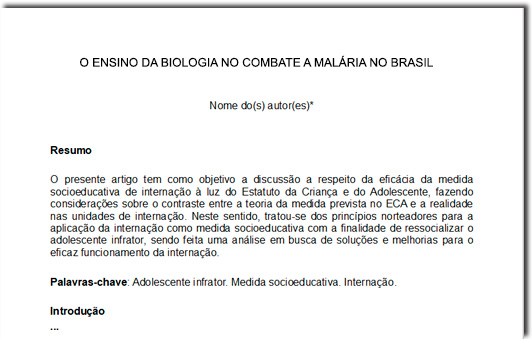
Diferente das monografias, os elementos pré-textuais nos artigos científicos devem estar juntos e na mesma página de abertura do conteúdo.
O resumo não poderá ultrapassar 250 palavras e as palavras-chave devem ser separadas entre si por pontos.
Atenção: a norma prevê ainda que a página de abertura deverá ter uma nota de rodapé contendo um breve currículo do autor, bem como seu endereço postal e eletrônico.
Elementos pós-textuais obrigatórios
Os elementos pós-textuais são apresentados após a conclusão do artigo e podem ser obrigatórios ou opcionais. Os elementos obrigatórios são: título, subtítulo (se houver), resumo e palavras-chave, todos em língua estrangeira e referências. Os primeiros devem seguir essa formatação:
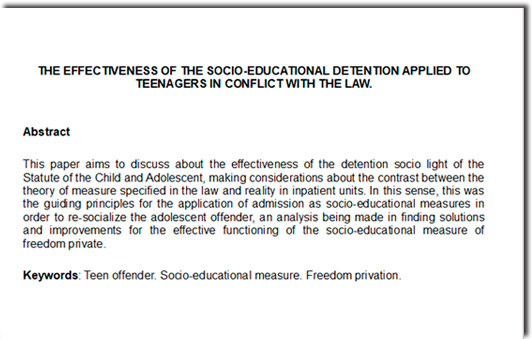
Apesar de a NBR 10520/2023 estabelecer que esses elementos são pós-textuais, é comum encontrarmos os resumos e palavras-chave em língua estrangeira na página de abertura do artigo.
As referências deverão seguir as normas previstas na NBR 6023/02 e serão formatadas da seguinte forma:
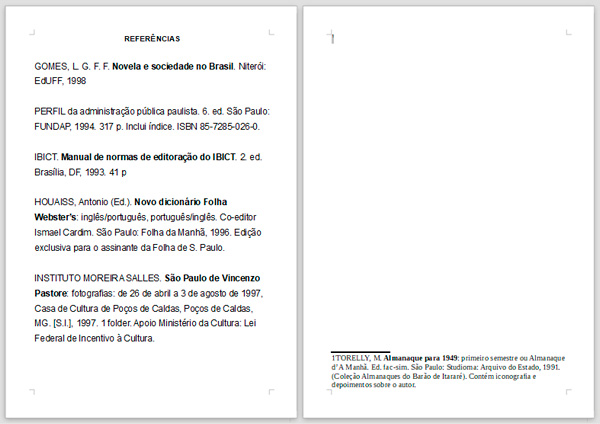
Exemplos retirados diretamente da Norma Brasileira n° 6023/2002.
As referências deverão conter as informações essenciais à identificação das fontes e, sempre que possível, informações complementares que facilitem esse reconhecimento. Diferente das monografias, as referências em artigos científicos não precisam constar em folha exclusiva, somente após a conclusão do trabalho ou em notas de rodapé.
Elementos pós-textuais opcionais
Os elementos pós-textuais opcionais são aqueles que ficam a critério do autor e consistem nas notas explicativas, glossário, apêndices e anexos.
Embora as notas explicativas estejam classificadas neste grupo, elas não são apresentadas após a conclusão do artigo, mas sim em notas de rodapé ao longo do texto. Elas são usadas quando o autor sentir necessidade de complementar algum ponto do artigo, seja com as suas próprias palavras ou com citações.
As notas explicativas e o glossário serão formatados da seguinte forma:
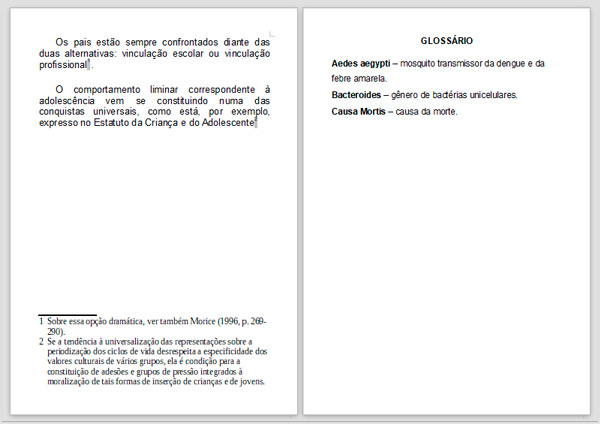
Exemplos de notas explicativas retirados diretamente da Norma Brasileira nº 10520/2023.
Vale mencionar que a numeração das notas explicativas não reinicia a cada página, devendo seguir consecutivamente até o fim do artigo. Com relação ao glossário, este deverá ser organizado em ordem alfabética.
Já os apêndices e anexos são documentos juntados pelo autor para fundamentar, comprovar ou ilustrar o conteúdo do artigo, e devem seguir esta formatação:
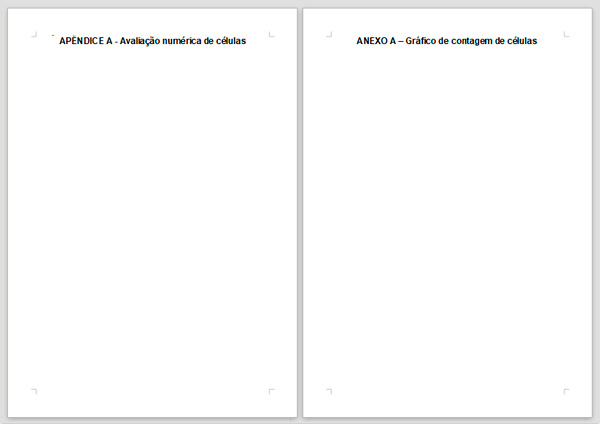
Conforme o exemplo acima, os apêndices e anexos deverão ser identificados por letras maiúsculas seguidas de travessão e a identificação do seu conteúdo.
English Version
- We use ABNT Standards
The Brazilian Association of Technical Standards – ABNT, among other attributions, is responsible for standardizing the formatting of technical documents, aiming to facilitate their understanding and access to scientific knowledge.
In this context, in addition to the norms aimed at academic works, ABNT edited the Brazilian Norm 10520/2023, which establishes formatting rules for scientific articles.
Considering that several colleges in Brazil already adopt the model of a scientific article as a course conclusion work, we at Revista Multiciência also use and gather here all the rules that must be observed in the formatting of your article.
Fonts, margins and spacing
Although NBR 10520/2023 does not establish rules about fonts, margins and spacing, we suggest using the same rules applied in monographs and other academic works:
Font: size 12, with the exception of footnotes, citations of more than three lines, pagination and image captions, which should be smaller.
Margins: 3 cm left and top, 2 cm right and bottom.
Spacing: should be 1.5, with the following exceptions, which should adopt single spacing:
quotes longer than three lines
footnotes
references
captions for illustrations and tables
General Structure
Structure and Elements
# Pre-textual
– Title and, if any, subtitle
– author’s name
– Summary in the language of the text
– Keywords in the language of the text
# Textual
– Introduction
– Development
– Conclusion
#Post-textual
– Title and, if any, subtitle in a foreign language
– Summary in foreign language
– Keywords in a foreign language
– Explanatory notes (optional)
– References
– Glossary (optional)
– Appendices (optional)
– Attachments (optional)
NBR 10520/2023 establishes that all elements inserted in the article must be structured in the order shown in the table above.
pre-textual elements
The pre-textual elements are those presented before the content of the article and consist of the title, subtitle (if any), author’s name, abstract and keywords in the language of the text. These elements must be formatted according to the example below:

Unlike monographs, the pre-textual elements in scientific articles must be together and on the same opening page of the content.
The abstract cannot exceed 250 words and the keywords must be separated by periods.
Attention: the norm also provides that the opening page must have a footnote containing a brief curriculum of the author, as well as his postal and electronic address.
Mandatory post-textual elements
Post-textual elements are presented after the article is completed and can be mandatory or optional. Mandatory elements are: title, subtitle (if any), abstract and keywords, all in a foreign language and references. The first must follow this format:

Although NBR 10520/2023 establishes that these elements are post-textual, it is common to find abstracts and keywords in a foreign language on the opening page of the article.
References must follow the rules set forth in NBR 6023/02 and will be formatted as follows:

Examples taken directly from Brazilian Standard No. 6023/2002.
The references must contain the essential information to identify the sources and, whenever possible, additional information that facilitates this recognition. Unlike monographs, references in scientific articles do not need to appear on an exclusive page, only after the conclusion of the work or in footnotes.
Optional post-textual elements
Optional post-textual elements are those at the discretion of the author and consist of explanatory notes, glossary, appendices and annexes.
Although explanatory notes are classified in this group, they are not presented after the conclusion of the article, but in footnotes throughout the text. They are used when the author feels the need to complement some point in the article, either with his own words or with quotes.
The explanatory notes and glossary will be formatted as follows:

Examples of explanatory notes taken directly from Brazilian Standard No. 6022/2003.
It is worth mentioning that the numbering of the explanatory notes does not restart on each page, but must continue consecutively until the end of the article. With regard to the glossary, it should be organized in alphabetical order.
Appendices and annexes are documents put together by the author to substantiate, prove or illustrate the content of the article, and must follow this format:

As in the example above, appendices and annexes must be identified by capital letters followed by a dash and the identification of their content.
